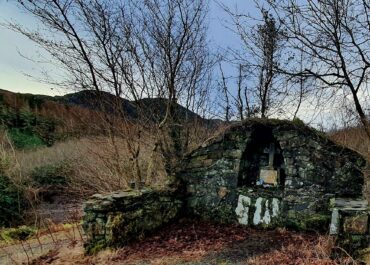Penal Mass station, Kill (Dunfanaghy Ed), Co. Donegal
In the old burial ground at Kill near Dunfanaghy, a curious stone platform built against the enclosing wall has puzzled archaeologists for over a century.
Penal Mass station, Kill (Dunfanaghy Ed), Co. Donegal
Initially catalogued by Borlase in 1897 as a possible dolmen, this masonry structure was later reclassified as a ‘prehistoric chamber tomb’ by researchers Killanin and Duignan in the 1960s. However, the truth behind this enigmatic feature may be far more recent; according to an Ordnance Survey Name Book from 1905, local clergymen would stand upon this very platform during burial ceremonies to collect death offerings from mourners, suggesting it served as a penal mass station during times when Catholic worship was restricted.
Archaeological investigations in the area have revealed little about the site’s deeper history. In 2006, archaeologist Eoin Halpin conducted test excavations approximately 60 metres north-west of the church site, digging four machine-cut trenches in advance of residential development. This work followed an earlier investigation from 1994, when eight trenches were excavated in the immediate vicinity. Neither survey uncovered any significant archaeological features, though Halpin’s team did note a stone ridge running alongside a north-south pathway on the western edge of the site; likely just spoil from creating the path rather than anything of historical importance.
The ambiguous nature of this monument speaks to the layered history of Irish sacred sites, where prehistoric tombs, medieval churches, and penal-era worship spaces often occupy the same ground. Whether this platform began life as an ancient burial chamber and was later repurposed for Christian ceremony, or was always intended for religious use, remains uncertain. What is clear is that it served the local community as a focal point for funeral rites well into the early twentieth century, bridging Ireland’s ancient past with its more recent religious traditions.


